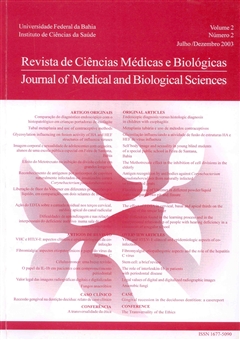Endoscopic diagnosis versus histologic diagnosis in children with esophagitis
DOI:
https://doi.org/10.9771/cmbio.v2i2.4265Keywords:
Esofagite, Diagnóstico endoscópico, Diagnóstico histológico, Esofagite em crianças.Abstract
The gastroesophageal reflux means the retrograde flow from the gastric content to the esophagus. The gastroesophageal reflux disease is the condition in which symptoms and/or digestive complications are present, including the esophagitis. The diagnosis of the esophagitis is made through the upper gastrointestinal endoscopy (UGE) and through the histopathologic evaluation of the esophageal mucosa. This study aimed at comparing endoscopical and histopathologic findings of that area in children with esophagitis. The results of 125 children’s UGEs and biopsies, aging 0 to 18 years old with esophagitis, from 1997 to 2001, were reviewed. Among those patients, 69 (52,20 %) were female. In the endoscopical results, 104 (83,20%) patients had edematous esophagitis; in the histological study, 48 (33,40%) children presented chronic esophagitis and there were no alterations in 29 (23,20%). When compared to the histopathology, the UGE results are not so trustful that one may only rely on that evaluation. It is mandatory the accomplishment of the biopsy for diagnosing this pathology and for future comparisons with the patient’s evolution. Multiple biopsies must be made in order to analyze comprehensively the whole process and to identify Barrett esophagus early.Downloads
Download data is not yet available.
Downloads
Published
2003-01-01
How to Cite
Pires, C. S., Paes, F. N., Barros, F. S., Melo, M. C. N. de, Franca, R. M., Mascarenhas, R., Baptista, S., & Silva, L. R. (2003). Endoscopic diagnosis versus histologic diagnosis in children with esophagitis. Journal of Medical and Biological Sciences, 2(2), 155–162. https://doi.org/10.9771/cmbio.v2i2.4265
Issue
Section
ORIGINAL ARTICLES
License
The Journal of Medical and Biological Sciences reserves all copyrights of published works, including translations, allowing, however, their subsequent reproduction as transcription, with proper citation of source, through the Creative Commons license. The periodical has free and free access.


